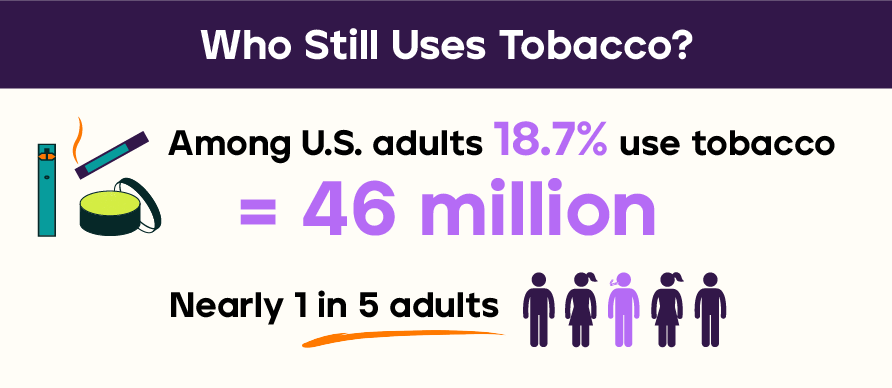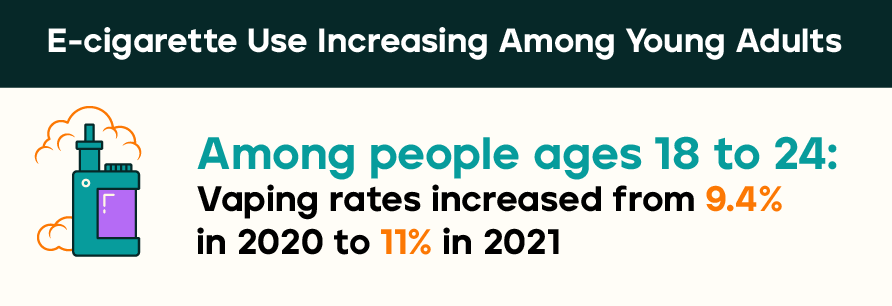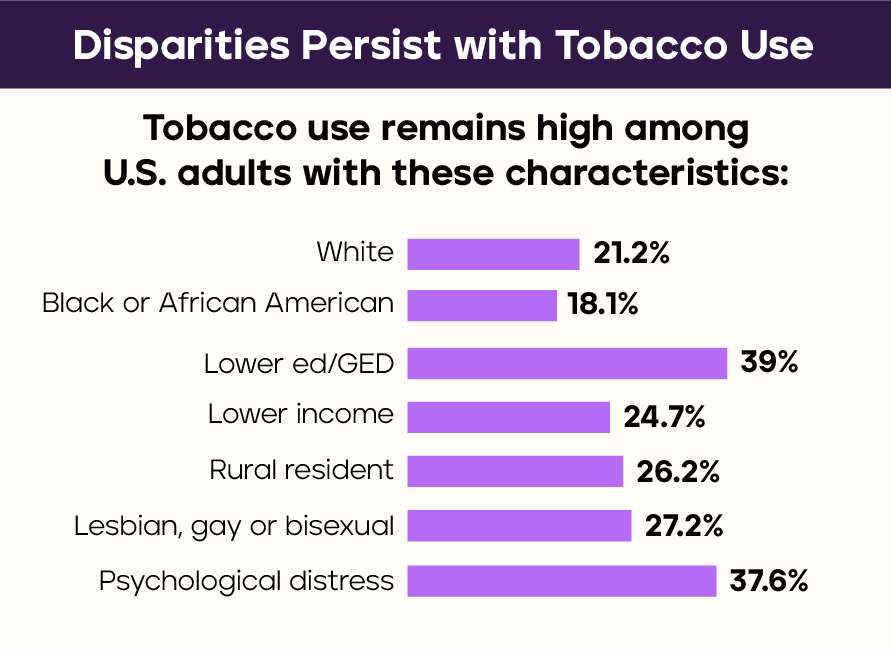In May, the Centers for Disease Control and Prevention (CDC) released new statistics about smoking and tobacco use among U.S. adults. The main finding was a headline-grabbing conclusion that cigarette smoking continues to decline.
That’s welcome news but it doesn’t tell the whole story. See 3 facts from the CDC’s new statistics about smoking and tobacco use that prove cessation efforts are as critical as ever:
1. Tobacco Use Is Still Too High
CDC data show that among U.S. adults, 18.7% use tobacco products.
That’s an estimated 46 million people, which is nearly 1 in 5 U.S. adults.
Even with declining usage, that number is staggering, and the CDC notes that tobacco product use remains the leading cause of preventable disease and death in the U.S.
2. E-Cigarette Use on the Rise
Overall, while cigarette smoking rates declined from 2020-2021, e-cigarette use rates increased, largely driven by people ages 18 to 24.
CDC data show that among this age group, vaping rates increased from 9.4% in 2020 to 11% in 2021. Many young adults are using e-cigarettes that contain high levels and a large volume of nicotine, which are linked to greater nicotine dependence and lower likelihood of intentions to quit vaping.
3. Disparities Remain with Tobacco Use
Digging into more specifics on the CDC data, it’s clear that disparities persist when it comes to usage, with high tobacco use remaining among:
- Certain races and ethnicities, such as Whites (21.2%) and Black or African Americans (18.1%)
- Those with a high school diploma (24.4%) or GED (39%)
- Lower-income individuals (24.7%)
- Rural residents (26.2%)
- Those who identify as lesbian, gay, or bisexual (27.2%)
- People with psychological distress (37.6%)
Groups like these face pressures that can make smoking cessation more difficult.
For example, Black smokers have been aggressively targeted by the tobacco industry, particularly with menthol cigarettes—which are easier to smoke and harder to quit.
Similarly, the LGBTQ population is among the hardest hit by tobacco in the U.S., in part due to social stigmas and discrimination. And for those with mental health conditions, nicotine can amplify symptoms of depression and anxiety, making it tougher to quit.
Why Cessation Matters
According to the 2022 benefits report from Society for Human Resource Management, health-related benefits were the highest-ranked benefit category in terms of importance among employers, more than retirement savings, flexible work, or family care.
Tobacco cessation is often noted as the most important thing an individual can do to improve their health. This is true not only because it helps prevent chronic diseases like heart failure and cancer—but it also provides mental health advantages. For example, smoking cessation is associated with reduced depression, anxiety, and stress, leading to an improved quality of life and positive mood.
Plus, helping people quit smoking is cost effective. See my blog post Smoking and Health Care Costs: How Soon After Quitting Do Companies See Savings for details on savings your organization gains when helping people quit.
Best Practices Improve Results
Addressing tobacco use to improve total health still matters, but simply offering tobacco cessation and hoping members or employees will enroll is not enough.
To be effective, we consult with clients on using best practices that we know work. These include using an incentive or surcharge, promoting the program year-round, nudging participants with tailored outreach, and more.
See more about how the EX Program works for participants on our Program page.
To learn more about our approach with employers and health plans, please complete a Contact Us form today.







